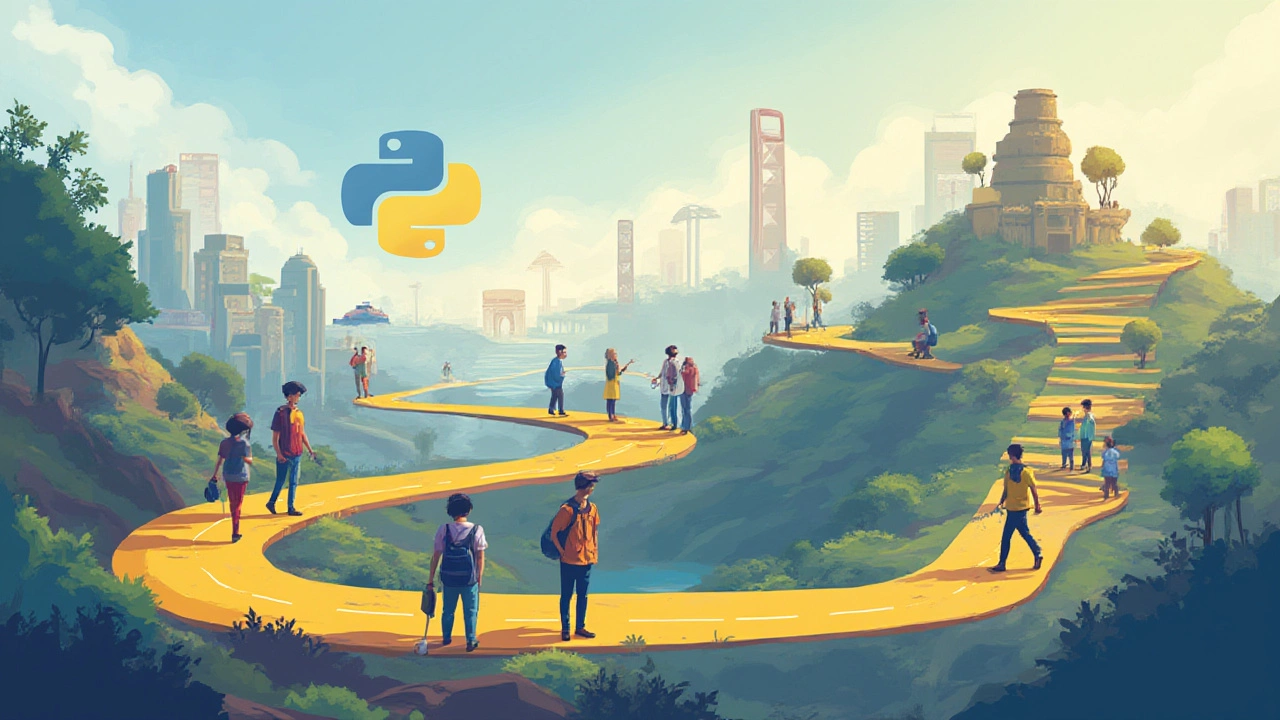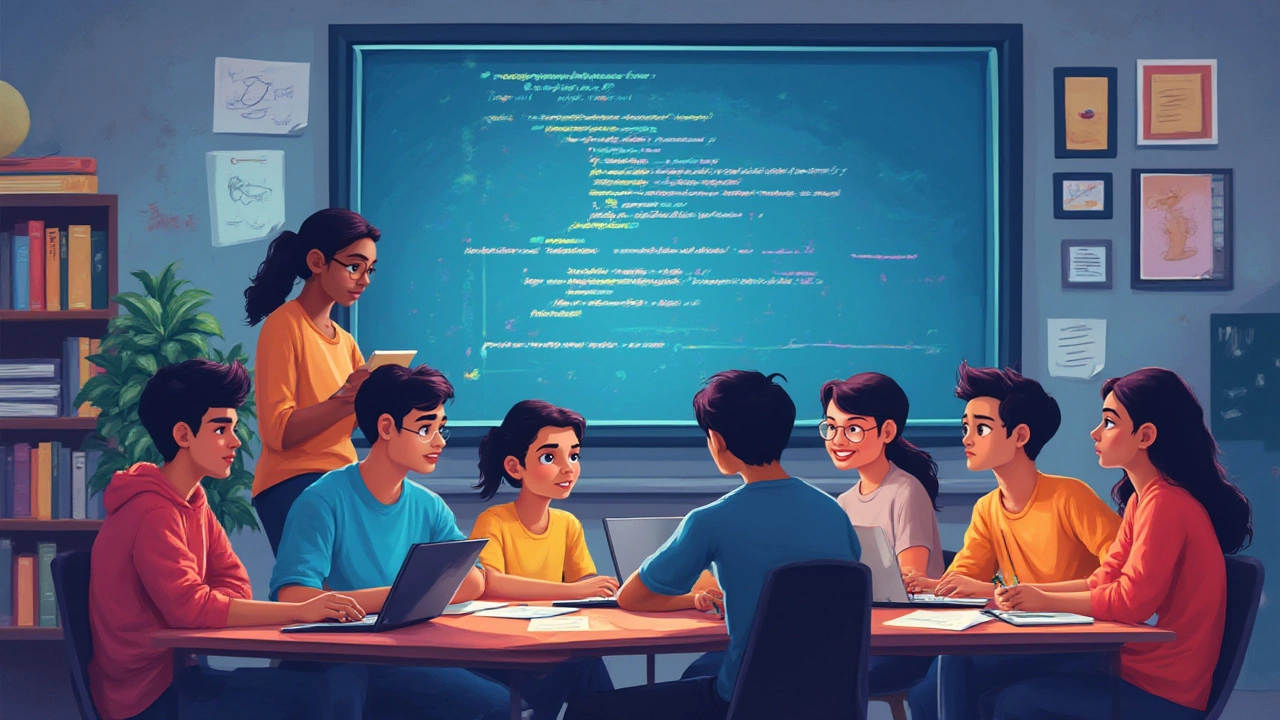Picture this: you’re scrolling through job ads or watching YouTube, and you keep seeing ‘Python’ pop up everywhere. People rave about it like it’s the Swiss Army knife of the tech world. But you might be thinking—can it really be that easy, or are people just hyping it up? Are you about to hit a wall of tricky code or can you dive right in, even if you’ve never written a line before? Python’s been around for over three decades (it launched in 1991!), and yet every year, more people start learning it from scratch. There’s got to be a reason for that.
Why Python Feels Simple (Even If You’re New)
Let’s cut right to it: the main reason Python draws so much attention is because it doesn’t have that steep learning curve you hear about with other languages. The biggest thing? Python code actually looks like ‘normal’ English. Here’s how that plays out in real life. Instead of squinting at semicolons and curly braces (hello C++ and Java), Python lets you set things up with straightforward words and plenty of whitespace. For example, here’s how you print ‘Hello, World!’ in Python:
print("Hello, World!")
Compare this with other languages that might require a small essay to do the same. Now, Python won’t magically write your programs for you, but just seeing readable code helps beginners feel like they aren’t completely lost.
There’s hard data to back it up, too. According to the 2024 Stack Overflow Developer Survey, 41% of people learning to code pick Python as their first language. That’s huge! Folks are jumping in from fields like biology, marketing, and even music, not just computer science grads. The language’s design—created by Guido van Rossum—was intentionally built to minimize confusing rules so that the ‘average person’ could pick it up with less fuss.
But there’s more: self-taught programmers swear by Python because it doesn’t force you to memorize oddball symbols or convoluted rules. Python’s popularity is not some weird accident—schools and universities now include it in their curriculums, exactly because first-timers don’t trip over arcane syntax. This approachability isn’t a gimmick. It fuels curiosity, and when you’re curious, you dig deeper.
Common Sticking Points and How to Get Past Them
Of course, no programming language is like unwrapping a kid’s toy from a box. You’re bound to run into stuff that makes you scratch your head; Python’s no exception. A common tripwire for beginners is something called ‘indentation’. Unlike most languages that use curly brackets to separate chunks of code, Python demands you line up your code (using spaces or tabs) so that it’s clear what belongs where. Forget a space, and you’ll get an error faster than you can say ‘syntax’.
Another thing? Variables in Python aren’t glued to one type—if you give a value as a number, then as text later, Python won’t complain. Sounds cool, right? But it means bugs can creep in if you don’t keep track of what’s what, especially as projects get bigger. Beginners trip over this when their code suddenly acts weird because a variable changed in a sneaky way.
Then you’ll face ‘libraries’ (extra code you can use, like Lego bricks to build new things). Python has loads of them—maybe too many when you’re new. Navigating this sea of options can feel overwhelming. There’s NumPy for numbers, Pandas for tables, Matplotlib for graphs…starting out, the question becomes: which do you actually need?
Here’s what usually helps bust these roadblocks:
- When indentation errors hit, use a good code editor (like VS Code or PyCharm) that points them out in real-time.
- Test variables by printing them out as you go. Don’t wait for a big crash—catch mistakes early.
- Stick to the basics—master vanilla Python before pulling in too many libraries. Only add them when you hit a real need.
- Don’t skip ‘debugging’. Read your error messages, Google them (seriously, everyone does it!), and learn from the fixes.
- Practice with tiny projects, like a calculator or to-do list, instead of tackling a mega-app right away.
Python’s community is legendary here—forums like Stack Overflow and Reddit brim with no-judgment spaces for ‘dumb’ questions. Spoiler: every Python pro you’ll meet started with the same goofy errors.

The Myths About Python’s Learning Curve
You’ll hear wild things about Python—some true, some way off. ‘You don’t need any math skills to use Python’ is a half-truth. Plenty of folks use it for automation, web scraping, or simple scripts without breaking a sweat over algebra. But when you dip into specialized fields—machine learning, financial modeling, or quantum computing—numbers and logic start mattering. However, Python’s role is like a friendly guide, making the math part less scary by giving you tools that handle the grunt work.
Another myth: ‘Python is only for beginners.’ Not remotely. The world’s biggest companies—Google, NASA, YouTube, Instagram—use Python for mission-critical work. The difference is, a beginner might write a simple data scraper while a pro engineer builds AI systems or controls satellites, all with the same language. Here’s a fun fact: the Mars Rover’s software had parts developed in Python because engineers wanted to test rapid prototypes without fussing over lower-level details.
Some people swear by memorizing the entire list of Python commands before starting. Don’t buy that. Real progress comes from typing out code, breaking things, and fixing them. The brain remembers what it uses, not what it just reads about. Cheat sheets and Google are your friends—embrace them.
There’s also a rumor that Python is slow. Sure, for number crunching, C++ or Rust can be faster. But Python is ‘fast enough’ for most people’s needs, and in real life, the biggest slowdowns come from human confusion, not from the language itself.
Python in Real Life: What You Can Actually Build
Ever heard of Blender, the open-source 3D animation beast? Its scripting engine runs on Python. Same goes for YouTube’s backend, Dropbox’s desktop app, and countless indie games. Python isn’t just for classrooms or calculators.
| Industry | Common Python Use |
|---|---|
| Web Development | Building sites with Django/Flask |
| Data Science | Crunching numbers with Pandas/NumPy |
| Machine Learning | Training AI using TensorFlow/PyTorch |
| Automation | Task bots and scripts |
| Game Development | Prototype logic in indie games |
One jaw-dropping story: the movie industry uses Python for tons of behind-the-scenes magic—think Pixar and DreamWorks. They automate rendering, organize files, and smooth out animators’ work. That’s creativity meeting practicality.
If you dream up something—websites, games, analysis tools—it’s probably possible with Python. And if you’re stuck, odds are someone else already built something similar. Open-source code libraries are everywhere ready for you to peek at, borrow, or remix.
This friendly ecosystem means you don’t have to do everything from scratch. Being able to look at real-world projects speeds up your learning and helps squash doubts about whether you’re ‘doing it right’.

Tips, Tricks, and Resources for Mastering Python without Losing Your Mind
Before you leap into Python, some tips from the trenches can save you hours—or even days—of pain. First up, start with interactive tutorials, not just dry reading. Tools like Codecademy, freeCodeCamp, or even the vanilla ‘Python.org’ tutorial let you type as you go. The muscle memory sticks better that way.
Use is python hard to learn as your first search phrase on YouTube or Google—thousands have been where you are. Don’t rush to ‘master’ everything. The most efficient coders split their learning into pieces. Tackle one mini-project each week, like a weather fetcher, a text-based game, or a budgeting calculator.
Jupyter Notebooks make experimenting super low-stress. You write code in chunks, see what works, and keep notes alongside your results. Perfect for beginners and pros.
When you start working on bigger projects, try version control (like Git). It acts like a rewind button for your code, so you never have to panic about breaking something forever.
Join a community—Discord servers, Slack groups, the classic Stack Overflow crowd. Fresh eyes spot your typos in seconds and nudge you past mental roadblocks.
Finally, don’t fear ‘boring’ basics. Master the fundamentals—loops, conditionals, basic data structures—before chasing shiny frameworks. Once you’re comfortable, start adding challenges: teach someone else a trick, rewrite an old project the ‘clean’ way, or contribute a fix to an open-source tool you use. That’s how you move from beginner to confident coder.
The journey won't always be smooth, but Python smooths more bumps than most. There’s no secret handshake or IQ gate at the door. If you stick with it, you’ll realize Python’s true gift: it lets you focus less on fighting with the language and more on building things that matter.

